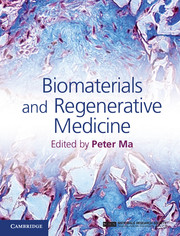Book contents
- Frontmatter
- Contents
- List of contributors
- Preface
- Part I Introduction to stem cells and regenerative medicine
- Part II Porous scaffolds for regenerative medicine
- Part III Hydrogel scaffolds for regenerative medicine
- Part IV Biological factor delivery
- Part V Animal models and clinical applications
- 25 Bone regeneration
- 26 Biomaterials for engineered tendon regeneration
- 27 Advancing articular cartilage repair through tissue engineering: from materials and cells to clinical translation
- 28 Engineering tissue-to-tissue interfaces
- 29 Models of composite bone and soft-tissue limb trauma
- 30 Tooth development and regeneration
- 31 Dentin–pulp tissue engineering and regeneration
- 32 Dental enamel regeneration
- 33 Hair follicle and skin regeneration
- 34 In-vitro blood vessel regeneration
- 35 Stem cells for vascular engineering
- 36 Cardiac tissue regeneration in bioreactors
- 37 Bladder regeneration
- Index
- References
26 - Biomaterials for engineered tendon regeneration
from Part V - Animal models and clinical applications
Published online by Cambridge University Press: 05 February 2015
- Frontmatter
- Contents
- List of contributors
- Preface
- Part I Introduction to stem cells and regenerative medicine
- Part II Porous scaffolds for regenerative medicine
- Part III Hydrogel scaffolds for regenerative medicine
- Part IV Biological factor delivery
- Part V Animal models and clinical applications
- 25 Bone regeneration
- 26 Biomaterials for engineered tendon regeneration
- 27 Advancing articular cartilage repair through tissue engineering: from materials and cells to clinical translation
- 28 Engineering tissue-to-tissue interfaces
- 29 Models of composite bone and soft-tissue limb trauma
- 30 Tooth development and regeneration
- 31 Dentin–pulp tissue engineering and regeneration
- 32 Dental enamel regeneration
- 33 Hair follicle and skin regeneration
- 34 In-vitro blood vessel regeneration
- 35 Stem cells for vascular engineering
- 36 Cardiac tissue regeneration in bioreactors
- 37 Bladder regeneration
- Index
- References
Summary
Tendon introduction
Tendon is one of the important components of the musculoskeletal system, which links muscles to bones, so that the tensile force created by muscles can be transmitted to bone for body movement. Tendon injury and defects are common diseases of the musculoskeletal system. Nevertheless, the treatment of tendon defects remains a major challenge to reconstructive surgery, partly because there is limited availability of autologous tendon grafts.
Regenerative medicine represents the future direction for tendon repair and functional recovery, in which stem cell therapy, tissue engineering, and regenerative materials will play important roles in tendon regeneration. Actually, engineered tendon repair might be the major contributor to tendon regeneration, because it can also integrate stem cells and biomaterials into tendon regeneration, although we are a long way from its ultimate translation to clinical therapy.
Scaffold materials
General requirements on tendon scaffold materials
As the major contributor to tissue regeneration, biomaterial plays a key role in engineered tendon regeneration, because it provides an essential scaffold for extracellular matrix (ECM) production and tissue formation. The main tendon extracellular matrix is type I collagen, which is highly organized in a hierarchy of bundles that are aligned in a parallel fashion. In addition, there are small amounts of other collagens and proteoglycans, such as collagens type III, V, XII, and XIV, decorin, and tenascin. In particular, the small linking proteins play important roles in enabling the structural integrity of tendon and affording it mechanical strength. This unique structure provides the unique biomechanical properties of tendon tissues. Therefore, the parallel alignment structure and mechanical strength should be considered for tendon scaffold design.
- Type
- Chapter
- Information
- Biomaterials and Regenerative Medicine , pp. 478 - 487Publisher: Cambridge University PressPrint publication year: 2014



